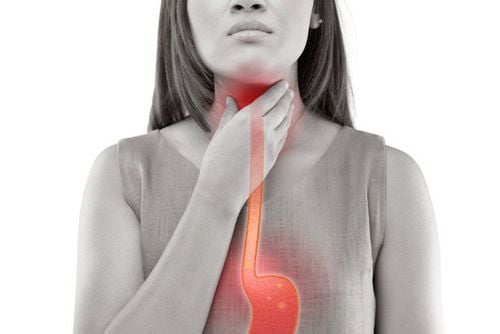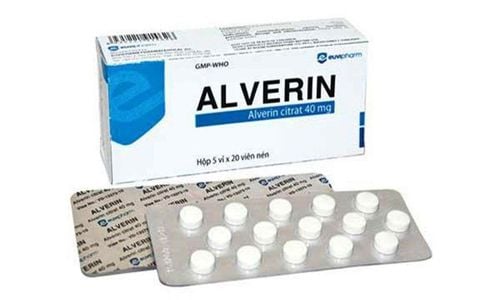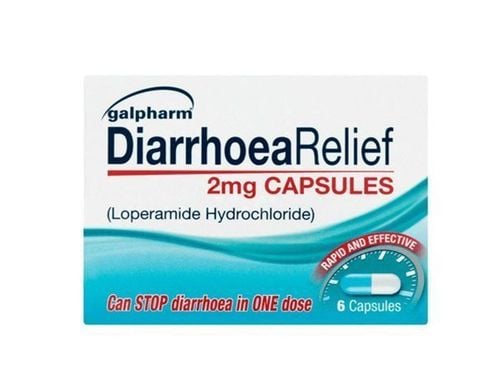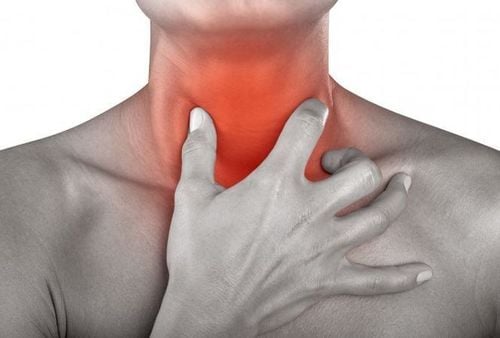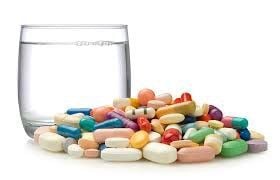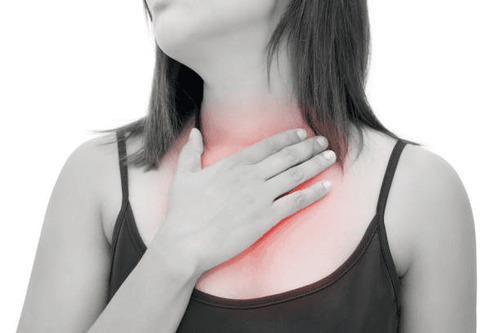This is an automatically translated article.
The article is written by Master - Doctor Mai Vien Phuong - Department of Examination & Internal Medicine - Vinmec Central Park International General Hospital.The esophagus is responsible for carrying food from the mouth to the stomach, where digestion begins. Efficient movement of the esophagus requires a coordinated, sequential peristaltic pattern that pushes food down from above, removing acid and refluxed bile from below. This disruption of highly engaged muscle movement is called esophageal motility disorder. It limits the supply of food and fluids, as well as causes difficulty swallowing and chest pain.
1. What is non-cardiac chest pain?
Noncardiac chest pain was defined as recurrent chest pain indistinguishable from ischemic heart attack after cardiac causes were excluded.Patients with noncardiac chest pain may feel chest tightness, tightness, or burning; May radiate to the back, neck, arms, and jaw and is indistinguishable from heart-related chest pain. In fact, patients with a history of coronary artery disease (CAD) may also experience noncardiac chest pain. Therefore, all patients with noncardiac chest pain should first be evaluated by a cardiologist to rule out cardiac angina. On clinical grounds, it is difficult to distinguish between cardiac angina and noncardiac angina. Furthermore, patients with noncardiac chest pain tended to report a higher incidence of chest pain and greater pain intensity. They also used more emotional descriptors than patients with ischemic heart disease.
2. Diagnosis of non-cardiac chest pain
Noncardiac chest pain (NCCP) is very common in the general population. However, based on history and patient characteristics alone, it is difficult to clearly distinguish cardiac and esophageal chest pain. When it comes to chest pain, a cardiologist's first priority is to rule out any life-threatening acute cardiovascular conditions; including acute coronary syndrome, aortic dissection, pulmonary embolism and pericardial tamponade.If these acute conditions have been excluded, evaluate for chronic ischemic heart disease or pericardial disease. Various tests can help determine the presence and severity of ischemia, left ventricular function, the shape of the coronary arteries, and ability to function. These tests include an electrocardiogram, echocardiogram, or single-photon emission computed tomography (SPECT). If the patient is unable to run or walk, the doctor will use drug echocardiography, nuclear SPECT, or cardiac MRI.

3. What is esophageal motility disorder?
Movement disorder is a newly discovered pathological lesion, accounting for a high rate, with more than 30% of the population having this disorder. Currently, the diagnosis and treatment are still more or less difficult.The esophagus is the first part of the digestive tract, composed of a very complex sphincter - longitudinal muscle system, subject to the influence of many interwoven factors; including central nervous system, peripheral nervous system, hormone levels,... Therefore, esophageal motility disorder is a very complicated issue while understanding biological function. reason is still poor.
4. Common types of esophageal motility disorders
The three most common types of esophageal motility disorders are diffuse esophageal spasm, achalasia, and gastroesophageal reflux.Diffuse esophagitis: Diffuse esophagitis causes chest pain, but less often than cardiac spasm. The cause is the loss of muscle coordination, so there is only movement of the lower esophageal muscle layer. This type of disorder can be treated with medications that reduce the esophageal sphincter. Cardiac spasm: Caused by the esophageal muscle not being able to relax. In the early stages, there may be a lot of pain when swallowing food or there may be difficulty in swallowing. When the disease is advanced, gradually dilating the esophagus will relieve pain, but the symptoms of dysphagia increase. This type of disorder is primarily treated with the use of dilatations or esophageal sphincterotomy. Drugs that relax the lower esophageal muscle are used only in the early stages. Gastroesophageal reflux disease: The cause of this disease is still unknown, however, the role of the lower esophageal sphincter is much discussed. Factors that weaken or relax muscles contribute to gastroesophageal reflux disease such as: Drinking alcohol, smoking; eating foods containing a lot of spices, fats, coffee, chocolate; medical conditions such as obesity, diabetes in pregnant women, diaphragmatic hernia,... The patient feels a burning sensation from the epigastrium spreading back to the sternum, sometimes up to throat; Symptoms worsen after eating, lying down or leaning forward. In addition to the above symptoms, the patient may also experience symptoms such as painful swallowing, vomiting, belching; hoarseness, sore throat, cough; increased salivation; bronchial asthma,... Currently, treatment with proton pump inhibitors is quite effective. Besides taking medicine, maintaining a reasonable diet will make an important contribution to the treatment of gastroesophageal reflux disease.
5. Esophageal motility disorders and noncardiac chest pain disease
Only a small number of patients with noncardiac chest pain have esophageal motility abnormalities. Several large studies have demonstrated that approximately 30% of patients with noncardiac chest pain have abnormal esophageal pressure. In a study of 910 patients with noncardiac chest pain, the authors found that 70% had normal esophageal motility. Nutcracker esophagus (cork esophagus) (14.4%) was the most commonly reported esophageal motility abnormality, followed by nonspecific esophageal motility disorder (10.8%). . Diffuse esophageal spasm, angina, and lower esophageal sphincter hypertension were rare in the noncardiac angina group.In one study, Dekel et al evaluated 140 patients with noncardiac chest pain using the Clinical Outcomes Research database. Unlike the previous study that included patients from a large center related to esophageal motility, the study by Dekel et al included patients from more than 60 academic and private centers across the United States.
In this study, the authors also found that 70% of subjects had normal esophageal motility tests. Low esophageal sphincter pressure (61%) was the most common motor abnormality diagnosed, followed by lower esophageal sphincter pressure, nonspecific esophageal dyskinesia, and nodular esophagus. bottles (10% each). In this study, angina and diffuse esophageal spasm were also rare.

6. There is no consensus on the relationship between noncardiac chest pain and esophageal dysfunction
The relationship between noncardiac chest pain and esophageal dysfunction remains a subject of intense controversy because the literature on esophageal dysfunction during manometry is rarely associated with reports of chest pain symptoms. Furthermore, in patients with noncardiac chest pain who experienced simultaneous esophageal manometry and pH testing, chest pain was more often associated with acid reflux than with motor abnormalities.Even previous use of a 24-hour ambulatory esophageal manometer has not been able to improve the test's sensitivity in noncardiac chest pain. In fact, studies have demonstrated that, 27%-43% of patients did not report any symptoms of chest pain during the trial. Furthermore, researchers were able to link pain to esophageal dysfunction in only 13% to 24% of patients. Therefore, the routine use of a 24-hour ambulatory esophageal pH meter has been questioned and this technique is rarely used in clinical practice. In one study, the authors were able to demonstrate an improvement in symptoms of noncardiac chest pain in patients with corkscrew esophagus treated with antireflux drugs without affecting esophageal motility.
Some clinicians have suggested using esophageal motility abnormalities in patients with noncardiac chest pain as a marker for an underlying movement disorder. However, it is reasonable that the authors' current assessment techniques for the esophagus provide only preliminary information on motor function of the esophagus. Future trials will require providing a more comprehensive assessment of the anatomical and biomechanical structures of the esophagus and their relationship to noncardiac chest pain.
7. Conclusion
Our understanding of the epidemiology and natural course of noncardiac chest pain is still relatively limited. Overall, the disease is very common, does not have any sexual orientation, and has a good prognosis. More has been learned over the years that GERD, esophageal dysfunction, esophageal hypersensitivity, and comorbid psychological illness are important underlying mechanisms of noncardiac chest pain.Please follow the website: Vinmec.com regularly to update many other useful information.
Please dial HOTLINE for more information or register for an appointment HERE. Download MyVinmec app to make appointments faster and to manage your bookings easily.





